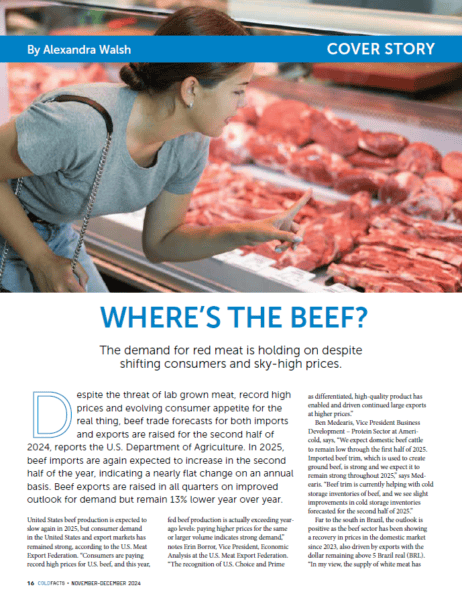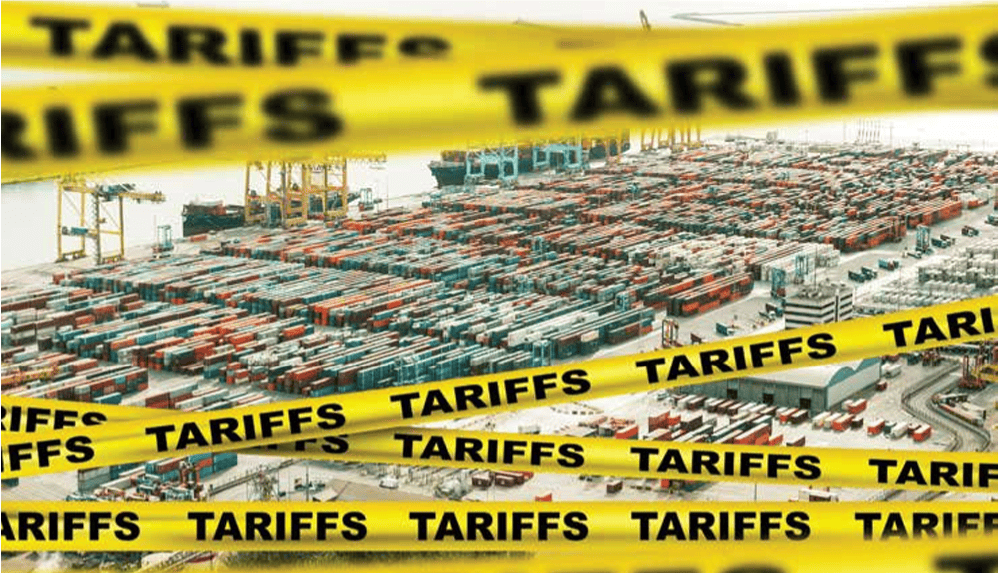From COLD FACTS Magazine (Click Image)
Read Below:
Where’s the Beef?
The demand for red meat is holding on despite shifting consumers and sky-high prices.
By Alexandra Walsh
Despite the threat of lab grown meat, record high prices and evolving consumer appetite for the real thing, beef trade forecasts for both imports and exports are raised for the second half of 2024, reports the U.S. Department of Agriculture. In 2025, beef imports are again expected to increase in the second half of the year, indicating a nearly flat change on an annual basis. Beef exports are raised in all quarters on improved outlook for demand but remain 13% lower year over year.
United States beef production is expected to slow again in 2025, but consumer demand in the United States and export markets has remained strong, according to the U.S. Meat Export Federation. “Consumers are paying record high prices for U.S. beef, and this year, fed beef production is actually exceeding year-ago levels: paying higher prices for the same or larger volume indicates strong demand,” notes Erin Borror, Vice President, Economic Analysis at the U.S. Meat Export Federation. “The recognition of U.S. Choice and Prime as differentiated, high-quality product has enabled and driven continued large exports at higher prices.”
Ben Medearis, Vice President Business Development – Protein Sector at Americold, says, “We expect domestic beef cattle to remain low through the first half of 2025. Imported beef trim, which is used to create ground beef, is strong and we expect it to remain strong throughout 2025,” says Medearis. “Beef trim is currently helping with cold storage inventories of beef, and we see slight improvements in cold storage inventories forecasted for the second half of 2025.”
Far to the south in Brazil, the outlook is positive as the beef sector has been showing a recovery in prices in the domestic market since 2023, also driven by exports with the dollar remaining above 5 Brazil real (BRL). “In my view, the supply of white meat has been stable, not leading to an increased supply,” observes Carlos Pelc, New Business Executive at UNIFRANGO. “The external market for red meat is behaving similarly to white protein, with China as one of the main purchasing markets.”
In the export market, Pelc believes the current trend of industrial plants increasingly seeking to containerize on site, minimizing shipments to logistics operators, will continue to dominate. “This is a strategy to mitigate costs and maximize profits,” Pec explains. “In the domestic market, the trend is for the main market players (industry) to be increasingly present at the point of sale, making the operations of picking and last-mile delivery to the final consumer highly relevant,” he says.
The Real Deal?
The protein meat market has grown in recent years, driven by several factors including increased demand for lab grown proteins from the growing number of vegans or vegetarian consumers looking for ways to supplement their protein needs. Market growth in plant based or lab grown proteins is also driven by consumers becoming more aware of the environmental impact of meat and are looking for healthy, ethical, sustainable and cost-effective alternatives.
Medearis says inventory for plant-based cultivated meat is forecasted to remain unchanged and the consumption trend is leveling out in the category.
“I understand that this market is niche, production is expensive, and there is not yet a scale that can support or provide economic viability,” says Pelc. “Additionally, there needs to be an identity created; today, ‘plant-based’ products mimic original meat.”
Plant based product demand was tiny and has diminished, says Borror. “A great example is the SIAL food show, where two years ago there was a huge presence of plant based products and hype and this year the footprint was minimal. Consumers choose real red meat for its taste and nutrition attributes.”
With the current competitive landscape and cold storage capacity added to the market, Medearis believes the biggest driver for the industry is cost control. “This goes for not only cold storage but over-distribution cost. With the low inventories of beef and more imports needed to meet demand, costs increase, and suppliers are always looking for better alternatives,” he says.
As parts of the world continue to develop, such as in Africa and Southeast Asia, there will be increased demand for meat and the cold chain is a necessary component of that demand, points out Borror. She adds that these regions will also rely on imports to meet part of their growing demand for meat, so cold chain infrastructure is needed at the port and within the markets.
“Even in a seemingly fragmented world, trade in meat is needed because of the natural resource restrictions,” says Borror. “We will continue to rely on ocean shipping and cold storage around the world to manage products and meet growing consumer demand for these delicious and nutrient-dense products.”
Borror adds that convenience will also remain a key driver with potential for value added, e-commerce, delivery and related infrastructure.
Freeze or Fridge the Faux
As with other products in the cold supply chain, with plant based or lab grown proteins there is a balance when choosing between refrigeration and freezing as the desired cold production, storage, and distribution method. From a food safety and quality standpoint, minimizing changes in temperature and state are important. However, a combination of freezing and refrigeration may make the most sense to maximize a product’s life in the cold chain according to experts.
Meaty Challenges
Pelc contends if the industrial sector believes that outsourced refrigerated logistics operations only serve to increase costs in the supply chain, there won’t be significant changes.
“What is needed is for the industry to understand that Logistics Service Providers should be an extension of industrial plants, allowing industry to focus on its core competencies, production and leveraging expertise in industrial processes, while partnering with us for outbound transportation, warehousing, picking, and food safety with last-mile delivery,” says Pelc.
For the domestic market in Brazil, Pelc says it’s essential to maintain the necessary qualifications for various markets. “We will certainly continue to excel in the production of these proteins, and we need to adjust the supply chain,” he says. “In other words, Logistics Service Providers can and should establish partnerships with the industry where both parties achieve economic balance in their operations, supported by appropriate phytosanitary measures at all stages.”
Borror points out this is the year of elections so there is some uncertainty on the trade policy front, and geopolitics are always a factor. The United States has the natural resource base and is ideal for red meat production, she adds.
“We are among the most efficient and sustainable producers in the world, and trade helps to both maximize the value of every animal we produce and provide that efficiently raised, nutrient-dense food to consumers around the world, including those where local production is limited,” says Borror and adds, “The red meat supply chain will remain resilient.”
“Overall, the beef supply chain is strong,” notes Medearis. “We believe consumer demand will continue to drive consumption regardless of geopolitical, regulatory and environmental changes and challenges.”




